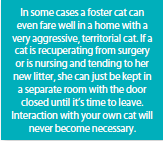Perhaps you’ve thought about saving a cat facing euthanasia at an overcrowded shelter by taking it in until a permanent home can be found, or fostering a cat for a rescue group that doesn’t have a brick-and-mortar facility to house it. But you’ve nixed the idea for fear that your own cat would hate sharing his space.
It’s true that your pet might very well be displeased about sharing his territory with a feline interloper — initially. If you take the right steps, however, you can probably make it work.
Temperament matching
Talk with the staff at the shelter or rescue about your own cat’s personality. If you have a

But if you have a calm cat, he may do well with, say, a sad cat who is missing his deceased owner and is lying around listlessly. Such a cat won’t pose a threat. Other potential pairings: two senior cats who would enjoying basking together in the afternoon sun’s rays, or two young cats who would enjoy getting into mischief while you’re trying to sleep.
A separate peace
No matter what cat you choose to bring home temporarily, things will go much more smoothly if you have a separate room or other space that you can dedicate solely to your foster cat at the beginning of his stay. That will give the cat who is your family member time to acclimate to the presence of “the stranger” through his sense of smell.
The separate room should have a window — the shelter will probably require it. It should also have places to climb, food and water bowls, a scratching post, a litter box, some toys, and a cardboard box with a towel placed inside — kind of like a feline studio apartment, and a vast improvement over the institutionalized setting of a shelter.
Keep the door to the room closed to prevent the two cats from meeting too soon and potentially sparring — although you may want to “introduce” them by sharing with each of them something the other has used, like a blanket; cats can learn a lot about a housemate through scent. And make sure to spend time with your visitor — at least an hour per day, with shorter visits here and there. Be certain to give the same amount of attention to your own pet. They know everything that has been going on behind closed doors.
A proper introduction
Let a week go by before cracking open the door by about 2 inches (you will need to create a wedge, perhaps with a heavy door stopper). That way, the cats can get a good view of each other without placing either of them at risk of aggression. Provide favorite treats to both cats at the same time so that they connect their time with each other as a pleasant experience that does not deprive them of anything that the other cat is getting.
You can also allow the cats to get more comfortable without risking any surprise attacks by setting up a baby safety gate. In a week or so, as long as both cats seem interested and relaxed, try removing the gate.
If taking it very gradually doesn’t work, you can always return the cat to the shelter. But if it does, you will have provided your own pet with some environmental enrichment while perhaps saving another cat’s life.





People also need to know that sometimes it can literally take 3 or more months for cats to get used to each other. Patience is a key factor. The cats need you to have a lot of it.